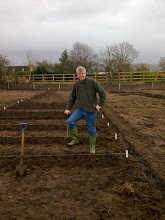After what seems like a long Winter break from any real work on the allotment I have eased myself back into the routine over the last couple of weekends by doing some preparatory work ready for the fast approaching growing season.
Last weekend I dug up the last few remaining potatoes on the plot. I had intended lifting them in November but didn't get round to it. And then when I found the time the potatoes were locked in the frozen ground. As expected, following December temperatures which had been as low as minus 18C, some of the spuds had turned to a milky mush and others were black and none were salvageable. This was disappointing because they had grown to a reasonable size and would have made good chippers and jackets spuds. If I had harvested them in time they would have been better than any of the others I had grown last year, all of which were on the small side (due, I think, to having followed Titmarsh's cock-eyed advice not to water them).
To add insult to injury, whilst I was breaking my back digging up these inedible and uncompostable potatoes and thinking of all the wasted effort and futility of having prepared the soil, dug the trenches, raked the mounds, weeded the beds and tended the plants all for nothing, one of my neighbours came over to show me his magnificent specimens which he had just dug up. He had planted them very deep in a double depth raised bed, given them plenty of water all Summer and then covered the bed with polythene in the Autumn. This had protected them against the Arctic conditions which we have experienced this Winter and he had a full bag of very large white beauties of which he was justifiably very proud.
Having removed my useless rotting potatoes I then relieved my frustrations by attacking the plot with my fork and spade. I really got stuck in to it and to my surprise managed to dig over the whole of last years potato patch, an area of about 5.5m x 7m, in what seemed like no time at all. I found this digging to be quite theraputic and by the time I had finished my thoughts had turned from futility to optimism for the coming season.
Fired up with enthusiasm for my coming second year on the plot I cleared out all the rubbish and remains of last years plants from the greenhouse along with the soil and gro-bag contents from the greenhouse beds. I then turned over the contents of compost box number one and was very pleased to see how well all the weeds and kitchen waste have broken down into lovely brown crumbly compost which will be ready to use this year.
I have also made a trip to Wilkinson and to the local garden centre, Silica Lodge (which offers a 10% discount to our allotment assosiation), this week and I have bought some veg seeds, seed potatoes (Arran Pilot and Maris Piper), onion sets (red and yellow) and some bags of multi-purpose compost.
Today I have stocked up on horse manure courtesy of my farmer friend Richard from the neighbouring village, or more accurately courtesy of his daughters' ponies Joey and Poppy. It took 3 trips to the farm and 3 full dust-bins and 18 assorted buckets and tubs to fill compost box number 3. As you can see from the photo below It doesn't look much but my back will tell you it is plenty.
So, everything is starting to take shape ready for year two on the plot and soon I'll be thinking of sowing my first seeds of the year, probably starting with chillis and tomatoes, but I also need to report my first set-back of the year. Today I discovered that my water butt, which has been full of ice for much of the last 8 weeks, was empty. On inspection I found two small hairline cracks in the base of the butt through which 220 litres of water must have escaped when the thaw came. This probably explains the pond behind the greenhouse which I referred to in my previous blog post. I will see if I can repair the cracks by melting a plastic patch onto them. If this fails the water butt will be recycled to become compost box number 4 or perhaps a cover for forcing rhubarb.
Speaking of rhubarb, I have seen the first pink shoots emerging today. Is this a sign that this harshest of Winters is coming to an end? I think not, it is still only January after all.










